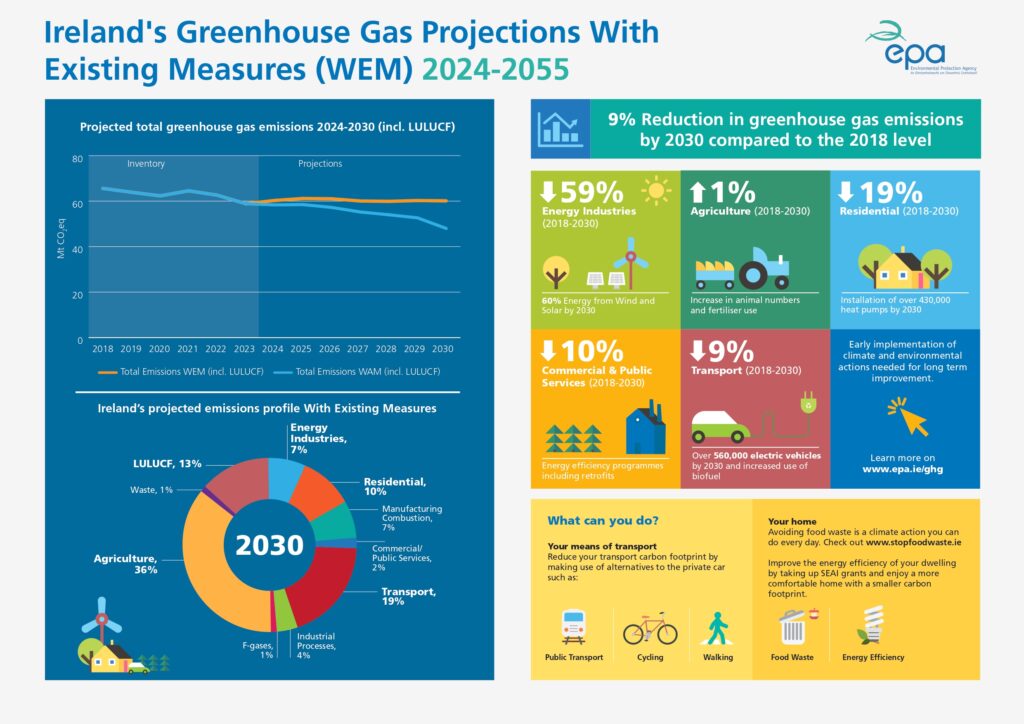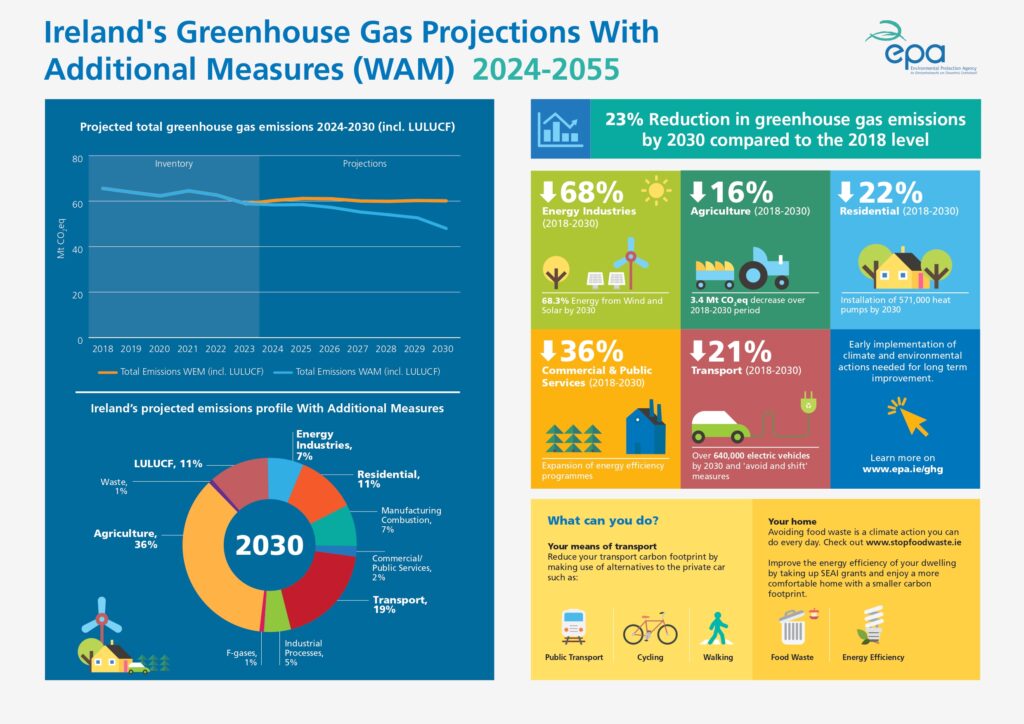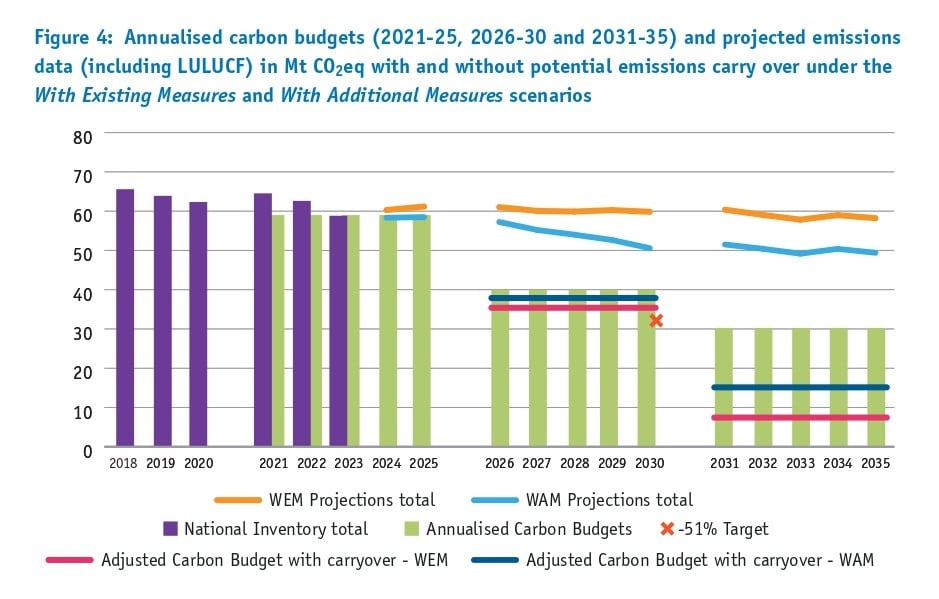Ireland’s Greenhouse Gas Emissions Projections: Understanding WEM and WAM Scenarios
Ireland’s latest greenhouse gas emission projections, as detailed in the Environmental Protection Agency’s (EPA) report, specially present two distinct scenarios—With Existing Measures (WEM) and With Additional Measures (WAM)—to forecast the nation’s emissions trajectory from 2024 to 2055. Understanding these scenarios is crucial for evaluating Ireland’s progress toward its climate targets.
What is the WEM Scenario?
The WEM scenario reflects Ireland’s greenhouse gas emissions projections based solely on measures already implemented or firmly committed to by the Government as of the end of 2023.
In other words, it includes only those policies and actions currently in place without any new initiatives. This scenario provides a baseline projection, showing the impact of existing commitments and legislation on Ireland’s emissions over the coming decades.
What Does the WAM Scenario Add?
On the other hand, the WAM scenario builds on the WEM foundation by incorporating additional planned measures. These measures, while not yet fully implemented, are under serious consideration and have a realistic chance of being enacted, typically by 2030.
The WAM scenario relies on the most recent government climate action plans—such as the Climate Action Plan 2024—and envisions a pathway where new policies further reduce greenhouse gas emissions beyond what the current framework achieves.
Why Are These Scenarios Important?
Both WEM and WAM scenarios are essential tools for policymakers, businesses, and environmental advocates. They highlight the difference between relying on current actions alone and the potential gains from additional targeted measures.
Crucially, the WAM scenario demonstrates how further commitments can accelerate Ireland’s progress towards its climate targets, reducing emissions faster and more substantially.
Projected Emissions Reductions to 2030
Under the WEM scenario, Ireland is projected to reduce total greenhouse gas emissions by just 9% by 2030 relative to 2018 levels—falling significantly short of national climate ambitions.
The WAM scenario offers a more optimistic outlook by including additional planned measures. If Ireland fully implements these, it could cut emissions by up to 23%. While this progress is meaningful, it still falls far short of the legally binding 51% reduction target for 2030, highlighting the urgent need to accelerate climate action across all sectors.
To help visualize these projections, the EPA provides a detailed two-page infographic that breaks down the data and key insights for both scenarios.
You can view the full infographic here: Ireland’s Greenhouse Gas Emissions Projections Infographic (2024–2055)


Sector-Specific Emissions Outlook
The projections below are based on the With Additional Measures (WAM) scenario. This assumes the successful implementation of policies outlined in the Climate Action Plan 2024. It also includes other planned initiatives with a realistic chance of being enacted.
- Energy: The energy sector will cut emissions by over 68% by 2030 by shifting away from fossil fuels and expanding renewable energy from wind and solar.
- Transport: Meanwhile, the transport sector plans to reduce emissions by up to 21% by deploying more than 640,000 electric vehicles and increasing biofuel blends.
- Industry: Industrial operators will lower emissions by about 12% through adopting carbon-neutral heating technologies and expanding biomethane use.
- Residential: Homeowners will contribute to a 22% emissions reduction by installing approximately 571,000 domestic heat pumps.
- Agriculture: Farmers can reduce emissions by up to 16% by limiting nitrogen fertilizer use and introducing feed additives that decrease methane output.
- Land Use: Although emissions may rise by up to 95% as forests reach harvesting age, policymakers plan to offset this increase with afforestation and peatland rehabilitation initiatives.
Carbon Budget Implications
Despite these projected reductions, the EPA warns that Ireland is likely to exceed its carbon budgets for both 2021–2025 and 2026–2030 periods under both scenarios.
For example, the first budget may be surpassed by 8 to 12 Mt CO₂ equivalent, while the second budget could be exceeded by 77 to 114 Mt CO₂ equivalent, considering carryover emissions.
This reality underscores the urgent need for enhanced efforts and accelerated implementation of climate measures to stay within legally binding carbon limits and long-term targets.

Conclusion
In summary, Ireland’s greenhouse gas emissions future hinges on the actions taken now and in the coming years. The WEM scenario sets a realistic baseline based on current efforts. While the WAM scenario offers a more optimistic outlook with additional planned measures. Monitoring progress against these scenarios will be critical for guiding effective strategies. This will help ensure Ireland stays on course to meet climate goals.
To turn these projections into progress, collaboration between public policy and private innovation is essential. This is where companies like Gamma Labs and its digital building performance tool, BERWOW, are making a tangible impact.
BERWOW helps homeowners and property professionals visualise energy upgrades and simulate potential improvements. This empowers them to make smarter, more sustainable choices that directly support residential and energy sector targets outlined in the EPA’s report.
These solutions demonstrate how data-driven tools and climate-focused technology actively drive Ireland’s carbon reduction efforts across multiple sectors. By connecting government ambitions with practical implementation, initiatives like Gamma Labs and BERWOW transform the WAM scenario from a projection into an achievable reality.



